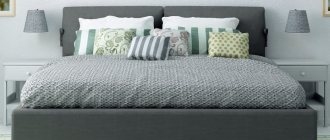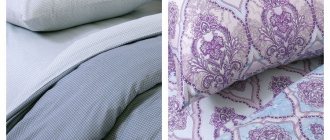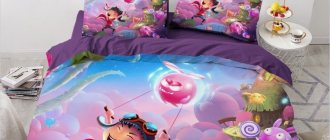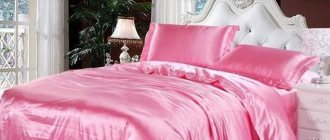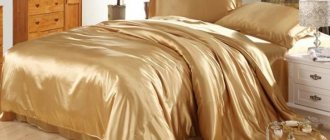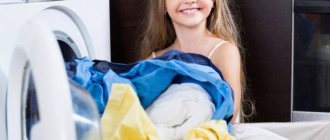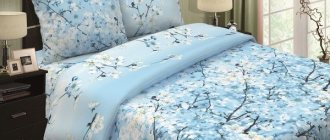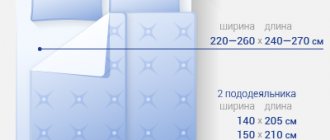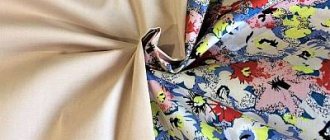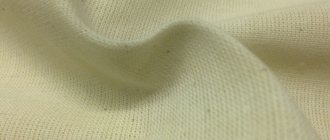History of fabric
The specific technology of percale weaving was first mastered in medieval India. Mass production of the material began at the end of the 17th century in French industrial manufactories. The fabric then had a technical purpose: additionally processed with oil or organic resin, it was used for the production of ship sails. At the dawn of aviation, the material impregnated with varnish began to be used to create parachutes and cover aircraft bodies. In the 70s of the 20th century, light camping tents were made from percale.
Photo source: Depositphotos.com
The introduction of thin threads into production brought the fabric into the sphere of household use: soft and durable percale home textiles quickly gained popularity.
What kind of fabric is percale?
What is percale?
By definition, percale is a high-strength cotton fabric made from untwisted threads.
Less often, but it happens that percale is made not from cotton, but from flax fibers. The composition may also contain silk, polyester and polyester. But the classic percale fabric is cotton.
Cupro - “copper” fabric for beautiful products
Percale: properties and qualities
The main thing for which percale is valued, in addition to its naturalness, is its strength. Percale was once even used to cover airplane wings! True, for this they took a particularly dense fabric, and even impregnated it with a special varnish. Then percale received the funny nickname “aviation baby diaper”. Tourist tents were also made from this fabric, and sails and parachutes are still made from it.
By the way, in the Russian language there are discrepancies regarding what gender the word “percale” belongs to. According to the rules, this is a feminine gender (percale - she), but in the context of use in aviation the word was more often used in the masculine gender, so now both variants exist.
So, even those types of percale that look not like sail material, but like ordinary calico-like fabric, are very durable. This property is achieved by production technology. Firstly, long cotton fibers are used - this in itself increases the strength of the finished fabric (read more about cotton fibers of different lengths and how this length affects the quality of textiles here). Secondly, the fibers are not twisted into threads, but are connected with a special indelible solution. This composition is safe and durable; it does not wash out after hundreds of washes. It also does not provide additional heaviness.
Properties of percale:
* strength;
* density even for thin fabric (down and feathers, for example, will not come out of a percale napkin);
* at the same time - lightness, hygroscopicity;
* resistance to peeling (no pellets form on the surface);
* wear resistance;
* prints on percale are clear and durable.
Poplin - “papal” cotton fabric
What is made from percale?
You can sew blouses, dresses, shirts from percale, but bed linen is primarily used from this fabric. Such linen can withstand up to 1000 washes! And the lightness, hygroscopicity, and naturalness of percale make the use of linen made from it pleasant and safe. Among European manufacturers, percale bed linen is usually classified as luxury.
What kind of fabric is cotton: properties, care, sewing recommendations
Percale, calico or satin?
* Percale differs from calico and satin, its closest competitors in terms of sewing bed linen, primarily in its strength: percale is stronger.
* The interlacing of threads in percale fabric is like in calico, in a simple checkerboard pattern. But the threads in the canvas are smoother due to the fact that they were not twisted. Therefore, the surface of percale is smoother than that of calico, but less smooth than that of silky satin.
* In terms of price, percale is usually somewhere in the middle between these fabrics: more expensive than calico, cheaper than satin.
Photo: peacockalley.com, bollandbranch.com, overstock.com, matalan.co.uk, biome.com.au
We sew bed linen with our own hands: a selection of tips and master classes
Life hack: how to sew a perfectly fitting pillowcase
3 types of fasteners for pillowcases
What kind of fabric is linen: properties, care, sewing features
How to cut fabric straight
Application
- The main area of application of percale is sewing luxury bedding sets. First-class percale linen ensures a comfortable, healthy sleep.
- Percale home textiles give comfort: bedspreads, tablecloths, decorative napkins.
- The material is used to sew pillow covers, mattress covers, and the top layer of blankets.
- Thin fabric is suitable for sewing wardrobe items: women's blouses, dresses, men's shirts.
- Technical percale is used in industry for sewing parachutes and awnings.
Bed linen and percale: friends or enemies?
The skin of the aircraft was left far behind.
Modern society prefers to sleep on this fabric rather than watch it in the sky. Moreover, having percale textiles at home is prestigious. Its presence speaks not only of good taste, but also of high income.
Elite bedding sets are exported to our country by the following countries:
- Italy;
- Portugal.
Previously, France was the leader in the production of high-quality percale home textiles. Today, the indicators are somewhat blurry, since almost all of Europe prefers pillowcases and sheets made from this fabric to other options.
However, increased demand does not in any way affect the cost of products. The average price of a set is approximately $460.
In our country you can purchase domestically produced products. Factories produce the following types of underwear:
- one-and-a-half-sleeping (suitable for children over 3 years old);
- double (standard set consisting of 2 pillowcases, sheets and duvet cover);
- euro (differs from the previous version in the size of the sheet and duvet cover);
- family (the duvet cover is smaller than that of a double bed, the sheet is larger).
For babies, textiles can also be made of percale. However, we recommend that you carefully read the composition before purchasing. Give preference to those options that are made of 100% cotton or linen without the addition of silk or polyester.
Description of the fabric: composition, properties, characteristics
Classic percale is a material made from long-staple combed cotton. The fabric is smooth, soft and delicate to the touch, surprisingly pleasant to the body. It retains heat, allows air to pass through, allowing the body to breathe, absorbs moisture, and does not accumulate static electricity.
The threads of the fabric fit tightly to each other, the percale does not show through. The linear density of the fabric ranges from 90 to 160 threads per 1 cm². Surface density is 72-150 g/m2 depending on the type of material.
Advantages
What fabric to choose for bed linen is up to you. As for percale, it has the following advantages:
- wear resistance and durability;
- nice smooth surface;
- ease of care;
- no formation of pellets on the surface;
- high degree of thread density (from 90 to 160 per cm²);
- easy to paint and retain color;
- the front and back sides are almost identical;
- low shrinkage after washing (no more than 3%);
- hypoallergenic material;
- promotes air circulation during sleep;
- has good hygroscopicity.
The cost of bedding sets will be slightly higher than traditional calico and satin, but more affordable than silk and other premium products. The service life of percale linen can reach 10–15 years, provided that the fabric care rules are followed.
Roman blinds with photo printing will add a special charm to your interior.
Photo of roller blinds for plastic windows for the kitchen: .
Before purchasing an orthopedic mattress, check out the standard sizes.
Types of fabric
Fabric is classified by composition:
- cotton percale;
- percale with added flax;
- material with polyester additives;
- percale with added silk.
Depending on the purpose, the material is divided into:
- household - intended for home use;
- technical - has a special purpose, used in industry.
Advantages and disadvantages
Percale has a myriad of advantages, among which it is worth noting:
- strength;
- softness;
- long service life: sets of linen can be used for up to 10-15 years;
- wear resistance: the fabric does not deform, does not fade in the sun, does not fade, and is not subject to pilling;
- pleasant tactile sensations and aesthetic appearance;
- saturation, color fastness;
- hygiene, comfort in use: the material is characterized by hygroscopicity, heat-saving properties, and breathability;
- impermeability: does not allow down and feathers to escape, maintains the integrity of the stuffing.
The disadvantages of the fabric include:
- shrinkage is possible within 3%;
- The components of the dressing can cause allergic reactions on sensitive skin.
Percale and its analogues
The percale material is similar in composition and consumer properties to poplin, satin and calico.
- Percale linen is a leader among its peers in terms of wear resistance and strength.
- Compared to satin, percale is harder, less smooth, and does not shine at all. Satin wins in visual appeal, but percale is more breathable, shape- and color-resistant, and wicks away moisture better.
- Compared to poplin, percale is denser and rougher to the touch. A clear advantage of percale is its low wrinkleability, while poplin requires ironing after each wash. In other characteristics, the fabrics are as similar as possible.
- Compared to coarse, rough-feeling calico, percale is famous for its smoothness, delicacy and softness, and has less weight and greater density. In other properties, high-quality calico is quite comparable to percale and successfully competes with it.
Care instructions
Percale is an easy-care fabric, but to maintain its attractiveness and unique properties it requires care and compliance with the manufacturer's recommendations.
General rules:
- The first wash is done in water at 30-45 degrees to maintain brightness and color saturation.
- For subsequent washes, temperatures up to 80 degrees are permissible. Linen should not be pre-soaked or boiled.
- Machine washable with spin speed up to 800 rpm. White linen is washed separately from colored linen. It is recommended to turn items inside out before washing.
- Do not use chlorine bleach; mild detergents are recommended. To soften hard water you need a conditioner.
- Dry percale products naturally, by hanging them and spreading them well on ropes or a special dryer.
- The optimal iron temperature for ironing is no higher than 150 degrees.
Features of care
Percale bedding should be washed at a temperature no higher than 60º, otherwise the fabric may become slightly deformed.
Iron from the wrong side at 150º. One of the main requirements for the “longevity” of the kits will be a ban on the use of bleaches and strong chemicals. The surface of the fabric can be easily washed with ordinary synthetic powder and does not require additional starching, but the use of a softening conditioner (especially during the first washes) will make the fabric softer and more pleasant to the body. The first wash is best done in slightly warm water, this will preserve and fix the coloring.
In general, percale bed linen must be washed before first use. This way you will not only ensure clean and hygienic sleep, but also slightly soften the structure of the fabric.
Recommendations for use
There are many low-quality fakes of percale on the textile market. To avoid disappointment, you need to carefully examine the fabric before purchasing.
- The percale weave is dense, in no way cross-shaped or circular, the fibers seem to be glued to each other.
- The fabric is dense, does not shine through, and is evenly dyed on the front and back sides.
- If possible, you can conduct a combustion test: it will help identify fake synthetics. A material with a predominance of cotton burns with a bright flame, spreading the smell of burnt paper around, and after extinction it smolders, forming ash. When polyester dominates, the fabric melts, spreading black smoke and a pungent odor, and bakes into a dense lump.
Manufacturers and brands
The material is produced by factories in Italy, Spain, France, England, Portugal, and Poland.
In Europe, percale is extremely valued and is called the royal fabric.
Among Asian countries, China, India, and Pakistan are famous for the production of percale.
Russian manufacturers are not lagging behind foreign ones. On an industrial scale, percale is produced at enterprises in the city of Ivanovo and the Ivanovo region, as well as at the famous Moscow Trekhgornaya manufactory.
Description and characteristics
The market for fabrics, clothing and home textiles does not often present something new. For example, a few years ago no one had heard anything about percale, but now this fabric in Europe is comparable in price to satin. In fact, this is not a new thing, but rather a well-forgotten old thing. The material was available back in the days of our grandmothers; bedding covers were made from it. The fact is that at that time feather pillows, feather beds, and blankets were made mainly from a mixture of down and feathers. Over time, hard feathers came out, which led to discomfort during sleep. The thick, smooth fabric for the napkins was perfect.
Despite the fact that the name of the fabric is translated from French as “rag” (percale), the country of origin of the fabric is considered to be India. It is very hot in this country and the following material was needed to make clothes:
- Soft;
- Thin;
- Has a cooling effect;
- Moisture absorbent;
- Air permeable.
The most common fabric at that time was calico. In India, they came up with the idea of processing threads to make them thin and smooth, and as a result, a fundamentally new material began to be made using the same calico simple weaving.
It quickly gained popularity, and not only as a fabric for tailoring and home textiles. If you process coarse threads, the scope of application will be much wider:
- Shipbuilding;
- Aircraft manufacturing;
- Rocket science.
It’s not for nothing that percale is also called parachute silk. We will tell you more about modern areas of application of fabric below.
Reviews of percale fabric
Percale receives a large number of positive reviews every day. Users cite the strength, durability, softness and beauty of fabric products as undoubted advantages. Buyers note the high cost of percale linen sets, but admit that the quality of the material speaks for itself; percale is definitely worth the money spent.
Owners are advised to pay attention to the capricious behavior of the fabric in care, to be especially careful when washing for the first time: incorrect actions lead to damage to things.
Percale is the queen of linen fabrics, it is a symbol of prestige, good wealth, gives pleasure, and attracts with the beauty of its appearance. A wide range of colors allows you to satisfy even the strictest personal preferences and enrich any interior.
Video: review of percale linen
The video shows five sets of bed linen, similar in design, but different in color. It explains how to care for percale linen, talks about densities, colors, and companion fabrics.
See similar articles
- Chintz is a lightweight cotton fabric for summer clothes.
- Milano - dense soft knitted fabric
- Choosing furniture fabric for cat and dog owners
- Microfiber is a synthetic fabric made from durable, thin fibers.
- Brocade - dense fabric with a pattern of metallic threads
- Natural silk - the fabric is smooth, durable and elegant
If you liked the article, share it with your friends!
Choosing bed linen: which is best for the family?
Home textiles for sleeping should be selected with special care, be it satin or cotton, calico or cambric or other materials. The bed linen (percale) described above receives excellent reviews, but it is advisable to familiarize yourself with the characteristics of each of the listed fabrics.
When compared with satin fabric, percale is more soft and velvety on both sides. Cotton fiber is used to make bed linen, which allows you to get a finished set that is very pleasant to the touch. The cost of satin, compared to percale, is more expensive, since the latter wrinkles more, but based on practical considerations, it wins due to its wear resistance. Satin is chosen by those housewives who prefer a more spectacular look for bedding sets.
